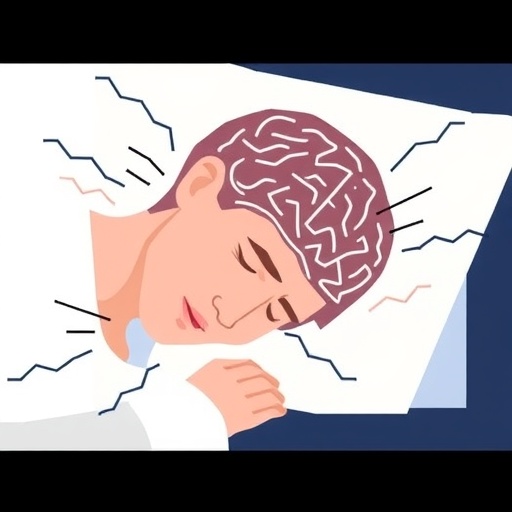In recent years, the complex interplay between mental health and respiratory disorders has drawn significant attention in medical research. One particularly puzzling relationship is that between depression and obstructive sleep apnea (OSA), a condition characterized by repeated interruptions of breathing during sleep. A groundbreaking study published in the journal BMC Psychiatry has utilized a combination of advanced statistical techniques and machine learning methodologies to unravel this connection with unprecedented clarity. The research leverages a large-scale dataset from the American National Health and Nutrition Examination Survey (NHANES) to explore how depressive symptoms may influence the risk of OSA and to identify key predictors within depressed populations.
The study is notable for its robust cross-sectional design, analyzing data from 14,492 participants, making it one of the most comprehensive investigations into these two correlated health issues. The researchers first employed weighted logistic regression to establish a statistically significant association between depression and OSA, with depression increasing the odds of developing OSA by 31%. This finding persisted across multiple models, underscoring a consistent positive relationship that adds critical epidemiological evidence to a previously equivocal field.
Beyond determining the association, the research team sought to explore the nuances of this relationship by conducting interaction effect analyses to see if any subpopulations exhibited differential risks. Intriguingly, no statistically significant interactions emerged across various demographic or health-related subgroups, suggesting that the depression-OSA link is broadly applicable across diverse segments of the population. This has vast implications for public health strategies, emphasizing the universal importance of screening for sleep apnea in patients presenting with depressive symptoms.
One of the most innovative aspects of the study was the integration of machine learning techniques to predict OSA risk specifically among individuals with depression. Employing a range of algorithms, including neural networks, random forests, and gradient boosting, the authors identified the neural network as the most effective model. It achieved superior performance metrics, including the highest Youden’s Index, area under the curve (AUC), and Cohen’s Kappa scores, thereby demonstrating impressive predictive reliability.
The power of this machine learning approach was further enhanced by the use of Shapley Additive Explanations (SHAP), an interpretability method that quantifies the contribution of each feature to the prediction. The SHAP analysis illuminated a multifaceted landscape of risk factors significantly associated with OSA in depressed individuals. Among the most crucial predictors were body mass index (BMI), age, marital status, hypertension, caffeine intake, sex, alcohol consumption, and fat intake. This multifactorial insight elucidates the complex biopsychosocial dimensions underlying OSA risk, going beyond simplistic clinical models.
Importantly, the identification of lifestyle variables such as caffeine and fat intake as influential predictors introduces novel avenues for therapeutic intervention and patient education. These findings highlight the potential for personalized lifestyle modifications to mitigate OSA risk among those battling depression, suggesting a holistic approach to healthcare that integrates diet, mental health, and sleep medicine.
Moreover, the clear link between hypertension and OSA among depressed patients reinforces the critical need for integrated cardiovascular assessment in this population. Since OSA has well-documented cardiovascular implications, early identification and management become pivotal in reducing the burden of secondary complications, thereby improving overall prognosis.
This research also stresses the significance of demographic details like age and marital status, often overlooked in clinical evaluations. Understanding these social determinants can enhance screening strategies, making them more socially sensitive and contextually appropriate, which is essential for improving healthcare equity and outcomes.
The implications of this study extend to clinical practice by advocating for routine assessment of depressive symptoms in patients diagnosed with OSA and vice versa. Such bidirectional screening could facilitate early detection, timely intervention, and personalized management plans that address both mental and sleep health concurrently, potentially breaking the cycle that exacerbates these co-morbid conditions.
Furthermore, the study sets a precedent for the application of advanced data-driven technologies in psychiatric and sleep research. The successful integration of machine learning with epidemiological data underscores the transformative potential of computational methods to enhance predictive accuracy and clinical decision-making.
The authors conclude by emphasizing the urgent need for healthcare providers to recognize depression as a significant risk factor for OSA, advocating for an interdisciplinary approach that integrates psychiatry, pulmonology, and lifestyle medicine. Their findings warn that neglecting depressive symptoms can delay OSA diagnosis, worsening patient outcomes and increasing healthcare costs.
In sum, this study represents a milestone in understanding the intricate relationship between depression and obstructive sleep apnea. By augmenting traditional epidemiological methods with machine learning and interpretability frameworks, it provides a comprehensive, data-rich foundation for future research and clinical interventions aimed at mitigating the intertwined burdens of mental health disorders and sleep apnea on public health.
Subject of Research: The association between depression and obstructive sleep apnea (OSA), and prediction of OSA risk factors in individuals with depression using machine learning techniques.
Article Title: Investigating the role of depression in obstructive sleep apnea and predicting risk factors for OSA in depressed patients: machine learning-assisted evidence from NHANES
Article References: Cheng, X., Liu, F., Zhang, X. et al. Investigating the role of depression in obstructive sleep apnea and predicting risk factors for OSA in depressed patients: machine learning-assisted evidence from NHANES. BMC Psychiatry 25, 964 (2025). https://doi.org/10.1186/s12888-025-07414-x
Image Credits: AI Generated
DOI: https://doi.org/10.1186/s12888-025-07414-x




